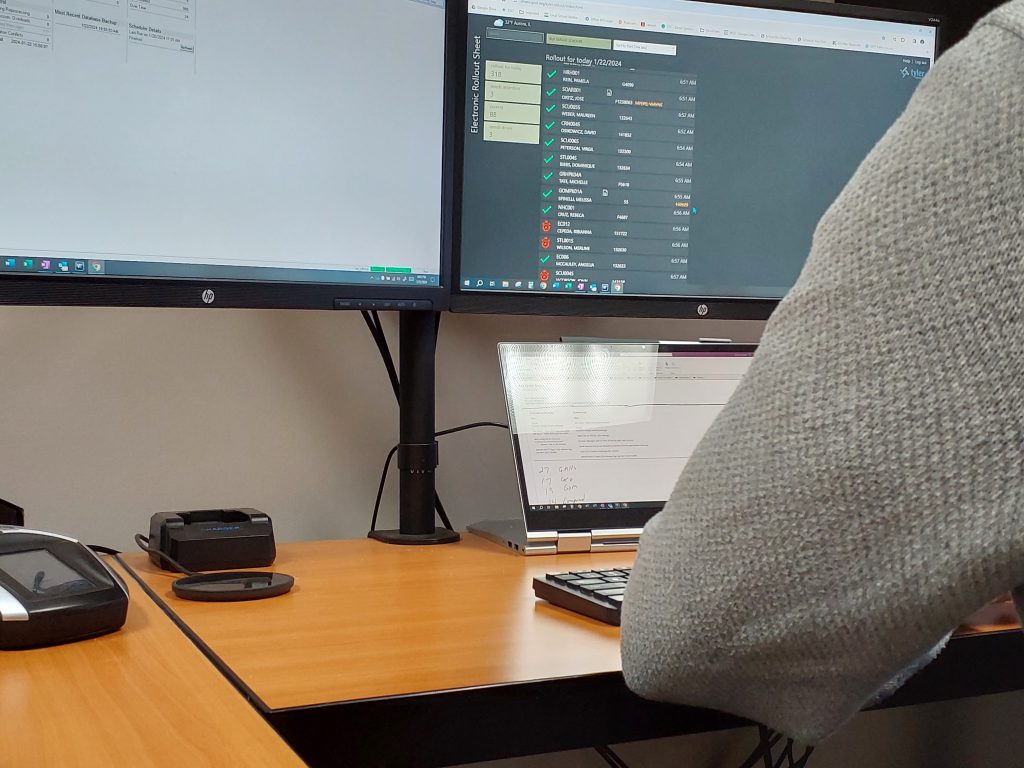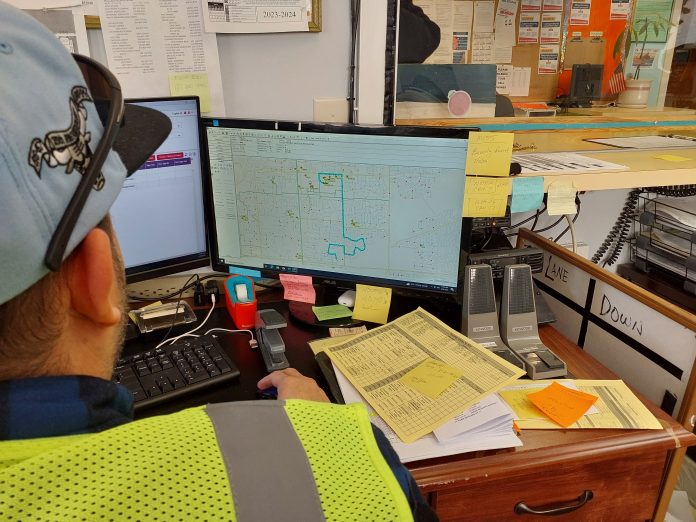Indian Prairie School District in Illinois, the fourth largest school district in the state, has an enrollment of about 27,000 students across 35 buildings. Ron Johnson, director of support operations, said 17,000 students are transported across a 55-square mile boundary, and while dispatching is no small task, technology is playing a big roll.
“Because of the size of our district, we have three dispatch centers,” Johnson said, adding that Indian Prairie contracts with First Student for its transportation operations. “The way we’re set up, is we do all the routing and then we push it through our database and then they assign the drivers and run the routes. At each dispatch location there’s anywhere from one to three dispatchers with a full training team and shop so vehicles that break down or preventative maintenance is fairly quick.”
He explained that while the initiatives, tech enhancements and improvements, and strategies are all driven by the district, First Student provides the employees, such as the dispatchers. “It’s all our software, all of our equipment that go into their buses, which is helpful when you have a good partner that lets you put your equipment on their buses.”
Due to the driver shortage, a dispatcher may have to cover a route every now and then. If that’s the case, Johnson said, and someone in management will fill in as a dispatcher for as long as is needed.
Johnson recalled years ago when transportation was 30 to 40 drivers short every day. However, he said, using driver tablets, as well as routing software and GPS technology has enabled transportation staff to “chop up” and reassign routes to other runs.
“It’s chaotic but every dispatch center is chaotic,” he added. “It’s managed chaos.”
Technology also cuts back on the number of calls from parents and schools asking where the bus is. Schools have access to the same level of GPS information, so if parents call the school, the school can provide that information.
“That level of information is at the fingertips of the school,” he said. “It’s at the fingertips of the dispatchers, the drivers.”
Johnson commented that if there’s a school bus job fair and one district offers a tool to make the driver’s job easier, applicants are more likely going to choose that district. “A lot of it is just making the drivers job easier with this tablet,” Johnson explained. “Like I said the drivers that were very reluctant are one of our biggest proponents. It’s so funny to see that that change.”
Updating the Dispatch Center
Johnson explained that about six or seven years, the community began demanding more technology and accountability from transportation. “Hey, how come I can order a pizza and track it when it gets to my house, but I don’t know where my students’ buses are,” he recalled hearing from the locals, adding that the technology existed but Indian Prairie buses at the time didn’t include GPS.
He said his district started looking at the different options and began to pilot the Tyler Technologies Student Transportation suite including Drive tablets. “I had a lot of good feedback from the drivers, just knowing where the students are on the route and how they’re assigned,” he said, adding that the sub drivers are able to see turn-by-turn directions and it enables changes on the fly.
Plus, he said, his department rolled out a parent tracking app about two years ago, after Tyler Drive was fine-tuned to work well within the operations. Johnson added that it took some time to get all the buses and drivers up to speed and on-board with the technology.
“There’s a lot of persuasion and drivers that were reluctant to use it because they thought it was more of a big brother tool,” he said, adding that for the drivers that were hesitant he allowed a slow roll process. In which if they weren’t ready to switch to the tablets, they could wait and see how other drivers responded.
Prior to joining the Indian Prairie School District in Illinois seven years ago, Ron Johnson had already attained a strong experience in planning and routing for special education transportation.
“I got to learn the ins and outs of students with IEPs and related services and bus seat, school bus equipment, wheelchair lifts and get very familiar with those processes,” he said of a smaller school district he worked for.
Then, an opportunity became available at Indian Prairie, where Johnson as the director of support operations was tasked with finding inefficacies and tightening up operations. He said it was during this time, he started looking at current software options and started purchasing technology solutions to help.
“But it made the operation a little bit more streamlined, gave us live data, real time information that we’re able to evaluate and identify what routes continued,” he said.
He explained that TV monitor screens on the walls of the dispatch center show driver status as they enter and clock in. If a driver is absent, it allows the dispatchers to see that information quickly and reach out to the driver and if necessary find another driver to cover the route.
The monitors also show the routes in real-time, so if a driver is late or hasn’t left yet that information is easily available. “[They’re] showing red instead of green,” Johnson shared. “I can start preparing or having the manager prepare to find another driver — maybe [the driver] just forgot to punch in and he’s already on the bus and on the road running his routes. But the dispatcher can log in and look screen which is tied to the tablet and see if [they’re] already running the route.”

Tablets also allow staff members to break up and add to other driver’s routes. These can be updated on the fly, even in the middle of routes.
“Prior to all tools and tablets at the dispatch center and the buses, we were about 80 to 85 percent on an on-time network, floating in between there depending on the day of the week,” Johnson relayed. “It went between 95 and 90 percent closer to 98 percent. Now we’re fine-tuning to make sure we’re really squeezing and identifying some of these low-hanging fruit drivers that are just consistently late and looking at their route path, congestion, building some delays. But that information we didn’t have it before.”
The technology, he said, is a huge safety improvement, especially since sub drivers no longer must look at paper route sheets. However, currently, the district has opted not to implement student ridership cards.
Dispatcher Training
Johnson explained that the Illinois Secretary of State and the State Board of Education partnered to create an Illinois school bus driver school bus permit training program and curriculum, that’s followed to a T. Plus, he said, First Student incorporates location specific training, such as using tablets, which has become a big part of Indian Prairie’s operation. The district uses software through Tyler Technology, and dispatchers are trained in how to utilize and navigate that.
“It’s kind of a skill that you’ve learned,” Johnson explained for training dispatchers. “We don’t just put new hires off the street into dispatch. If there’s a driver or office staff, support staff member that is interested in being a dispatcher, there’s a lot of shadowing that happens prior to that. There’s no dispatcher class. It’s a lot of on the job, skill set acquiring.”
He explained that dispatchers need to build their skill sets over time. For example, he said two of the district’s current dispatchers have been drivers for seven years, so they understand what it takes to drive the bus and how they need to be efficiently dispatched.
Related: Student Transportation Adds Perspective to Uvalde Mass Shooting
Related: Unforeseen Liability: The Impact of Transportation Personnel Shortages
Related: Illinois Bill Permits School Bus Safety Equipment Pilot Testing
















